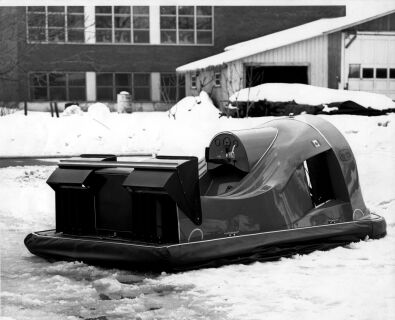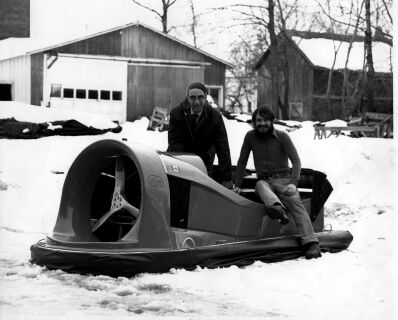| A very maneuverable and advanced design for a Hovercraft was developed and built by Romanelli Engineering. Using a single engine for lift and propulsion, and a thrust reverser as a brake. These vehicles can be produced in various sizes and would be suitable for recreation, commercial, governmental and military use. Complete drawings available. |
 |
 |
| MK-1 AIR CUSHION VEHICLE |
|
This 1-2 passenger Hovercraft has a 350 lbs. payload capacity and is highly efficient in relation to cost and functionality. The body is constructed of fibre reinforced plastic and expanded foam. This assure positive flotation and good impact resistance. One engine with a single propeller is used to lift and propel the craft. Approximately 30% of the air displaced by the propeller is used for lift, by deflecting it in a compression chamber under to direct the air flow in relation to the skirt, thus increasing lift. The cushion is contained within an inflated skit made of reinforced plastic. The rest of the air displaced by the propeller is forced through two variable venture tubes, and exhausts at the rear of the craft, thus providing forward thrust. A speed of 50 M.P.H. is achieved by a 50 H.P. engine. Directional control is obtained by two sets of rudders connected to a steering wheel. One set of rudders is located aft of the craft, the other set is located laterally to the front. Since the front rudders work opposite to the rear ones, and are controlling the air flow to the side of the craft by being positioned in the forward section of an inverted NACA duct, very good control and directional stability are achieved. A thrust reverser, located at the rear of the craft and operated by pedal, is used as a brake. There are many advantages to this design: The reduction in weight and cost by using a single engine; the much simpler layout of the components; the reduction in half of the components, thus increasing reliability; the ability to carry a bigger payload for the size; the complete enclosure of the power unit, resulting in increased safety. Additionally, placing of the driver and passenger between the two venture tubes protects them from the environment, such as dust, water and snow. |